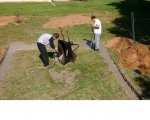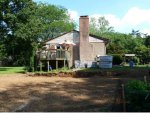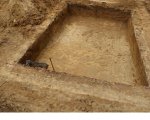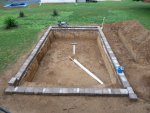I aggree with JC that if you are going with concrete filled block, you will need to pour a footer. Whether you go with a full 36" deep footer as JC suggested or a pier style as I suggested, you are going to need one. Sand and gravel base won't cut it for a block wall and it will shift someday. On just sand and gravel I would expect cracks in the walls in less than 2 years from sinking and shifting.
I did the pier footings becasue it was less digging. 17 years and no problems. You have to remember that the water is always against one side of the walls and the ground underneath the footers and so it acts somewhat as a heater to the ground and concrete immediately around the pond. I.e your concrete footer will always have water next to it that is 33F or higher. Pond temps 2-3 ft down are often in the high 30's to low 40's. It is almost impossible, even in Chicago to build up more than about 14" of ice on the surface. I don't think I have ever had more than about 6-8" build up in my pond.
That said, don't forget you'll need to take care of the ice on the top of the pond that will expand and put additional pressure on your walls as well. An 8-10" thick block of ice on the top can easily pop a wall, even if you keep a stock heater in it to keep a hole in the ice. Floating 2-3 plastic milk jugs with a few pebbles in them to keep them just a tad submerged in each corner allows a buffer for ice expansion. Tie them together to as when they get crushed they can leak and fill with water. They don't do anything then and will need to be replaced. You'll be amazed at how the jugs get crushed! As I think JC mentioned in an early posting, the greatest pressures are in the corners.
If you go 20" wide and 15" deep for the footer and use rebar, that is a pretty significant chunk of concreate. Combined with piers going down to 36-40" inches I don't think you'll have a problem. Not with the pond water up against it all. Plus a 2' concrete wall sitting on top of it all.
But you have to be comfortable with what you build. On the other hand, if you are digging a 15 inch trench, how much harder to dig a 36" inch trench? (Answer: at least twice as hard!)
Craig
I did the pier footings becasue it was less digging. 17 years and no problems. You have to remember that the water is always against one side of the walls and the ground underneath the footers and so it acts somewhat as a heater to the ground and concrete immediately around the pond. I.e your concrete footer will always have water next to it that is 33F or higher. Pond temps 2-3 ft down are often in the high 30's to low 40's. It is almost impossible, even in Chicago to build up more than about 14" of ice on the surface. I don't think I have ever had more than about 6-8" build up in my pond.
That said, don't forget you'll need to take care of the ice on the top of the pond that will expand and put additional pressure on your walls as well. An 8-10" thick block of ice on the top can easily pop a wall, even if you keep a stock heater in it to keep a hole in the ice. Floating 2-3 plastic milk jugs with a few pebbles in them to keep them just a tad submerged in each corner allows a buffer for ice expansion. Tie them together to as when they get crushed they can leak and fill with water. They don't do anything then and will need to be replaced. You'll be amazed at how the jugs get crushed! As I think JC mentioned in an early posting, the greatest pressures are in the corners.
If you go 20" wide and 15" deep for the footer and use rebar, that is a pretty significant chunk of concreate. Combined with piers going down to 36-40" inches I don't think you'll have a problem. Not with the pond water up against it all. Plus a 2' concrete wall sitting on top of it all.
But you have to be comfortable with what you build. On the other hand, if you are digging a 15 inch trench, how much harder to dig a 36" inch trench? (Answer: at least twice as hard!)
Craig






